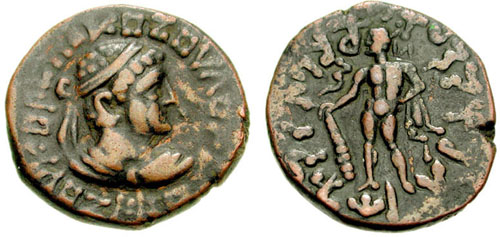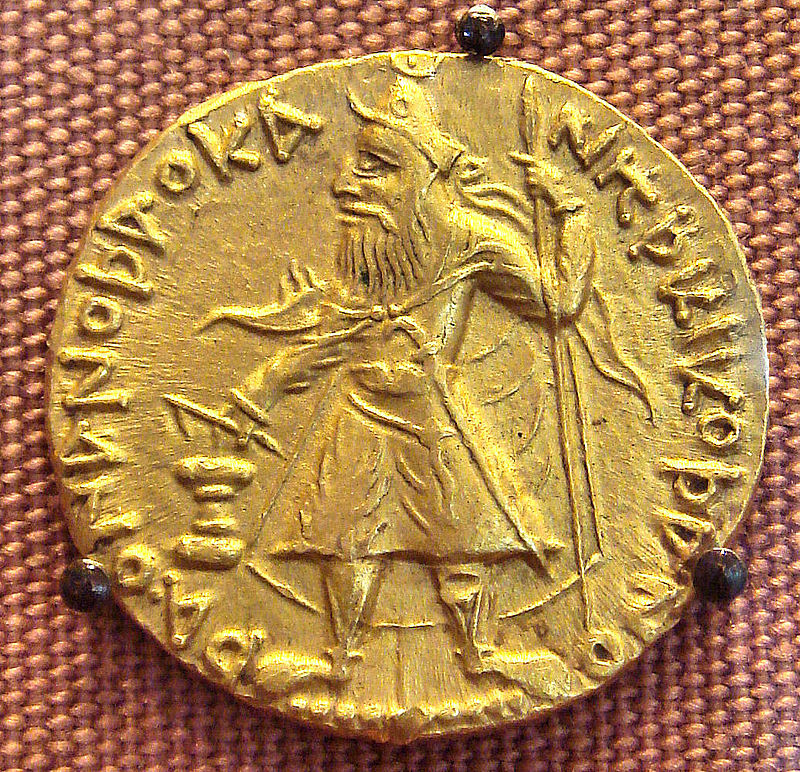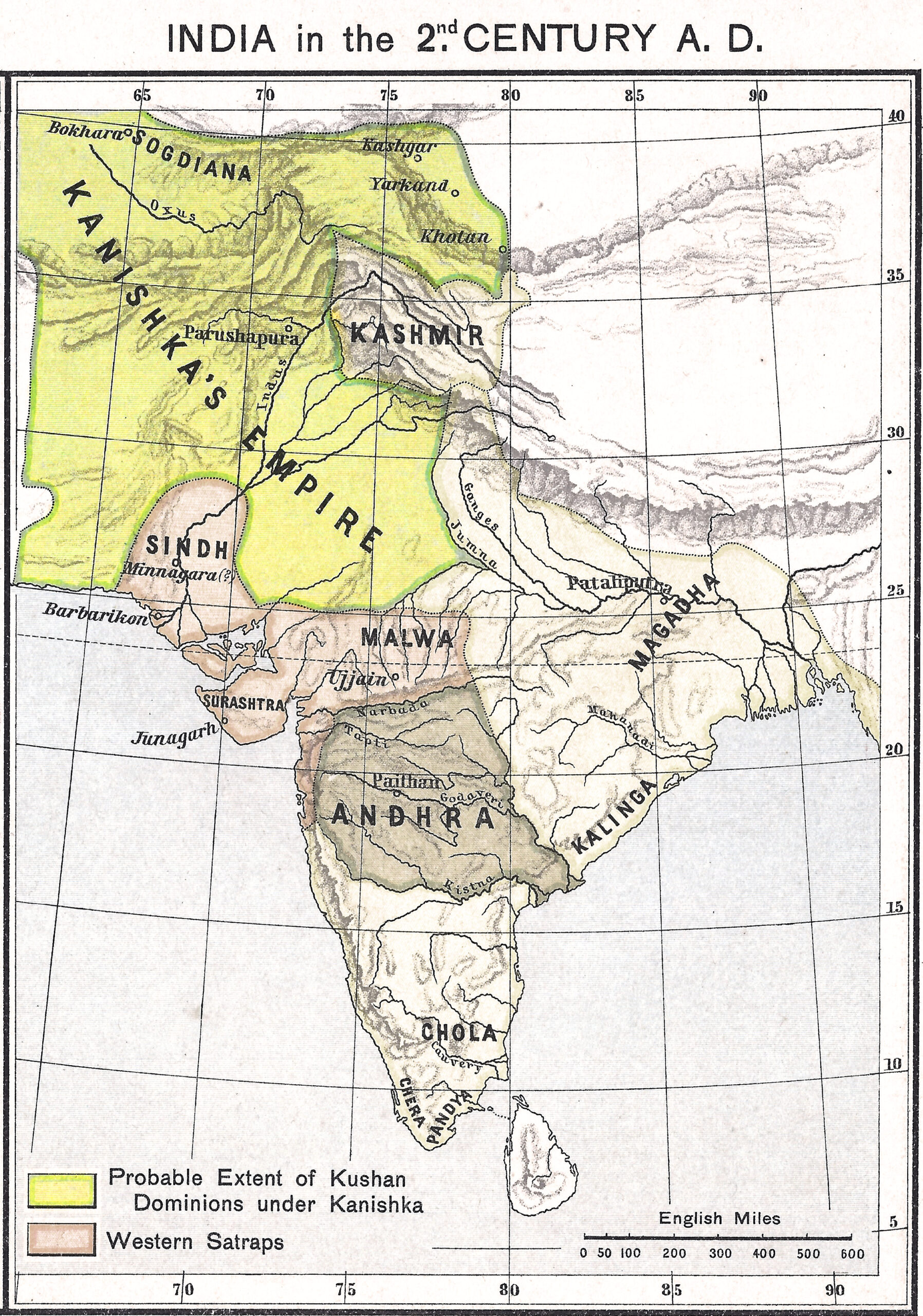Kushanas are considered to be one of the five branches of the Yuezhi tribe who lived in the Chinese frontier or central Asia. They are known as Guishuang in Chinese sources. They eventually acquired dominance over the other Yuezhi tribes. They moved eastward towards India defeating the Parthians and the Sakas in the 1st century AD.
Kujula Kadphises (Reign: AD 30-AD 80) or Kadphises I

Kujula Kadphises was the first Yuezhi chief to lay the foundation of the Kushana Empire in India. He established his supremacy over Kabul, Kandahar, and Afghanistan. He was succeeded by his son Vima Taktu or Sadashkana (AD 80 -AD 95) who expanded the empire into northwest India.
Vima Kadphises (Reign: AD 95-AD 127)

An inscription found at Rabatak in Afghanistan mentions that he was the son of Vima Taktu and the father of Kanishka. He has issued a large number of gold coins. He was a Shiva devotee as is clear from coins issued by him. A large number of Roman gold coins found from this era indicate the prosperity of India at that time and also the growing trade with the Romans.
Kanishka (Reign: 127 AD – 151 AD)

He was considered the greatest Kushana king and also a great king of ancient India. He was the son of Vima Kadphises. His kingdom included Afghanistan, parts of Sindhu, parts of Parthia, Punjab, Kashmir, parts of Magadha (including Pataliputra), Malwa, Benaras, perhaps parts of Bengal, Khotan, Kashgar, Yarkhand (the last three in modern China). His empire covered Gandhara, Peshawar, Oudh, Pataliputra, Kashmir, and Mathura. His kingdom also included parts of Uzbekistan and Tajikistan. His main capital was Peshawar, then known as Purushpura.
After the capture of Pataliputra, he is said to have taken away the Buddhist monk Ashvaghosha with him to Peshawar. The scholars in his court included Parsva, Ashvaghosha, Vasumitra, Nagarjuna, Charaka, and Mathara. He also patronized the Greek engineer Agesilaus.
Kanishka convened the fourth Buddhist Council at Kundalvana in Kashmir. He patronized Buddhism although he was very tolerant of his religious views. His coins contain a mix of Indian, Greek, and Zoroastrian deities. He was also a patron of art and architecture. The Gandhara School of art flourished under him. He also propagated the Mahayana form of Buddhism and he was largely responsible for propagating it in China.
Significance of the Kushana Empire
Sanskrit literature began to be developed during this time. The fourth Buddhist council was held in Sanskrit. Ashvoghosha is considered to be the first Sanskrit dramatist. During this time, three distinct schools of art flourished: Gandhara School in northwest India, Amaravati School in Andhra, and the Mathura School in the Ganges valley.
Trade prospered between India and China, and India and the Roman Empire. The Kushanas controlled large parts of the Silk Route which led to the propagation of Buddhism into China. It was during this time that Buddhism began to spread to Korea and Japan also.
Many towers, Chaityas, towns, and beautiful sculptures were built under the patronage of the Kushana kings. Kushanas were foreign invaders, to begin with, but they were completely Indianised in ways and culture. It is said that the Kushana period in Indian history was a perfect forerunner to the golden age of the Guptas.
The decline of the Kushana Empire
Kanishka was succeeded by his son Vasishka. Vasishka was followed by Huvishka and Kanishka II (son of Vasishka). Kanishka II was followed by Vasudeva I. Vasudeva I was the last great king of the Kushanas. After his death, the empire disintegrated away. He probably died in 232 AD.
Kushanas coins & their historical significance
The age of Kushanas witnessed a very high level of monetization. The Kushana king issued coins made up of gold, silver, coppers. In entire Ancient Indian History purest gold coin was issued during the Kushanas period. The maximum number of copper coins was also issued during the Kushana period.
A large number of coins have been discovered belonging to Kushana’s age. These coins were used by Kujala Kadphises, Wima Kadphises, Kanishka, and Huvishka & Vasudev. Information is provided by these coins through light on the history of the Kushana period.
Coins issued by Kujala Kadphises contained the epithet of Dharmathidasa. This title indicates that he had adopted/embedded Buddhism. Coins issued by Wima Kadphises depict God Shiva with Nandi & Trident. His title Maheshwar is found on the coins. This evidence confirmed that Wima Kadphises was a follower of Shaivism.
Coins issues by Kanishka depict a large number of deities of Indian as well as Iranian origin. These deities have been identified as Shiva, Buddha, Sun, and Moon & Shakti. The names of some deities were written in the Iranian language. These multiple deities & language indicate that parts of Iran were within the Kushana Empire.
Coins of Huviska depict Buddha, Shiva, Vishu, Kartikeya, and Goddess Shakti. Coins issued by Vasudev depict Shiva & goddess Parvati. On some of the coin, Shiva is depicted while killing Gajasur. These Kushana coins through light on political & economic as well as socio-religious history. The names of Kings found on coin & dates help in fixing the chronology of Kushana rulers. The titles adopted by Kushana Kings helped in understanding their political status.
The language used in the coin informed that the Iranian & Persian group residing in the Kushana Empire. Coins also indicate that Kushana rulers adopted Indian religion. Depiction of multiple deities on coins reveals the liberal tolerant & broadly based on the outlook of Kushana Kings.

